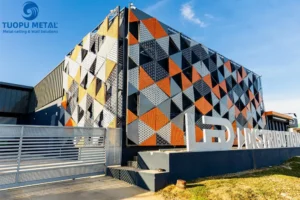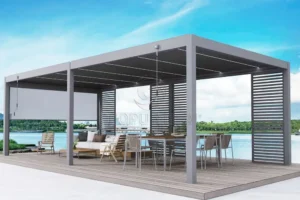Aluminum honeycomb panels’ unique lightweight characteristics combined with high strength and multiple functional capabilities makes it a revolutionary material for industrial applications. That’s the reason professionals in almost every field such as engineering, manufacturing, and architecture find aluminum honeycomb panels highly useful.

Learning About Aluminum Honeycomb Panel
What Are Aluminum Honeycomb Panels?
Aluminum honeycomb panels are made of two extremely thin aluminum outer sheets enclosing a core with a honeycomb pattern. This build enables the panels maintain a lightweight design while having a strong frame, making them suitable for advanced industrial use. Aluminum honeycomb panels leads the market as being the lightest and toughest of all.
The Science Behind Honeycomb Structure
The genius of aluminum honeycomb panels is best appreciated in the honeycomb style design. The core strucure contains hexagonal cells, giving the design a lightweight yet solid structure. By reducing the quantity of materail used, this configuration increases strength. Panel’s extended capabilities of enduring massive stress without the addition of any weight makes it ideal for aerospace parts and skyscrapes alike.
Aluminum Honeycomb Panels are Made by Manufacturers Using A Range of Techniques
The engineering process used to make these panels calls for precise technology. The initial stage of the honeycomb core production process starts with welding together thin aluminum sheets into a honeycomb lattice framework. The cores are then bonded together through the application of special adhesives or other advanced bonding methods. An aluminum skin layer is then attached to achieve the desired strength and durability.
Uses of Aluminum Honeycomb Panel
Aluminum honeycomb panels are well known for their scope and use of applications in a number of industries. In this section, we cover the most important applications that demonstrate their wide range of services.
Building Use
Aluminum honeycomb panels are a preferred selection in architectural design for facades, internal partitions, ceilings, and floors. Their appealing look and multiple finishes selection makes them popular for use in commercial and residential settings. In addition, these panels are energy efficient because they ease the terms of insulation, resulting is less energy spent ion heating and cooling. Furthermore, these windows are cost beneficial because they are durable, require low maintenance, and do not get damaged by weathering, making them suitable for high quality and long lasting serve.
Aerospace Industry
In the aerospace sector, aluminum honeycomb structures are most appreciated for their weight and strength-to-weight ratio and are most used for aircraft and spacecraft. These barrels allow to save fuel due to overall weight reduction without compromising on weight. Used in various parts such as fuselage sections and internals partitions, these components guarantee performance and safety in air and space travel.
Marine Applications
Along with other advantages, aluminum is the main choice for marine applications due to low weight and corrosion resistant properties. They find application in ship building, offshore facilities, and other marine constructions of high strength and durability. Because of exposure to saltwater and severe weather, materials used in these areas need to be extremely strong, making aluminum hone.
Automotive and Transportation
In the transportation sector, aluminum honeycomb panels are used in the construction of vehicles to reduce the weight of the vehicle while at the same time increasing strength and safety. They are used in cars, buses, and trains to improve fuel consumption and, as is normal in the industry, safety. In the industry, vehicles are designed with fuel economy in mind while not sacrificing necessary features.
Industrial Applications
Aluminum honeycomb panels are employed in several industries, ranging from clean room and machinery enclosures to storage systems. A combination of their light weight and resistance to varied working environment makes them ideal for the demanding conditions present in the manufacturing and pharmaceutical sectors. They give strength and precision while lowing down costs ensuring the best outcome possible.
Benefits of Aluminum Honeycomb Panels
Lightweight Structure
As it is easier to manage, transport, and install these panels, their core design aids in providing ease to industries like aerospace and automobile. This is because these aluminum panels are lightweight and strong, as the honeycomb core design offers an easily usable structure.
High Strength-to-Weight Ratio
While maintaining a lightweight build, these aluminum panels offer a high strength-to-weight ratio. With the ability to outperforming many other structures, their core efficiently distributes weight for tremendous strength in everything from marine engineering to transportation and even large scale commercial projects.
Corrosion Resistance
Aluminum honeycomb panels resist corrosion. They work well in tough environments. Whether exposed to moisture or extreme weather, they stay strong and need little maintenance.
Thermal and Sound Insulation
The honeycomb structure helps with thermal insulation and soundproofing. This makes the panels good for energy efficiency and noise reduction. They also make residential and commercial buildings more comfortable.
Aesthetic Versatility
The panels are available in a variety of colors and finishes. Architects and designers can create modern, sleek, or textured surfaces. These panels work well for both interiors and exteriors.
Environmentally Friendly
These panels are made from recyclable materials. They also reduce energy use during transport because they are light. This helps with eco-friendly construction goals.
Innovations in Aluminum Honeycomb Panel Design
Customization for Specific Applications
From custom sizes and finishes to unique configurations, the advancements in technology allow aluminum honeycomb panels to adequately serve unique needs. This kind of flexibility is beneficial for industries such as architecture, automotive, aerospace, etc., since every project has an optimal design.
Integration with Smart Technology
More advanced smart technologies such as energy management systems and environmental monitors have been integrated in aluminum honeycomb panels. Such features greatly improve building performance as structures can now react to dynamic conditions allowing a more efficient and adaptable space.
Enhanced Fire Protection Performance
Modern innovations ensure that aesthetics are never sacrificed. Fire resistant coatings and other materials now guarantee that fire safety, as well as the panel’s durability to endure high risk environments, is always protected.
Sustainable and Eco-friendly Developments
The construction industry’s move toward green building practices is further supported by the use of modern honeycomb panels that utilize recycled aluminum and sustainable production methods making them eco-friendly.
Issues and Their Resolutions Regarding Aluminum Honeycomb Panels
Issues in Installation and How to Solve Them
Due to the lightweight aluminum honeycomb panels, proper installation is labor intensive and challenging. Having specialized tools for installation can reduce the chances of damage during installation and ensure proper training is conducted to facilitate more effective installations.
Costs Issues
The greater initial investment associated with aluminum honeycomb panels is offset by their greater durability, energy efficiency and lower maintenance needs over time, making them economical in the long run.
Further Trends for Aluminum Honeycomb Panel
Further Trends for Economical Architectural Construction
Effective aluminum honeycomb panels are much cheaper and easier to use when manufactured using modern methods. Doing so will improve the construction of these products as well as allow a wide range of uses so developing these technologies is essential in increasing the further cost effectiveness of these materials.
Economical Construction Adoption
With the growing concern over energy use and associated greenhouse emissions, aluminum honeycomb panels are expected to be an important component of modern economical and recyclable architecture designs.








